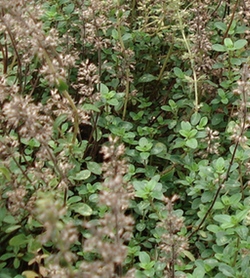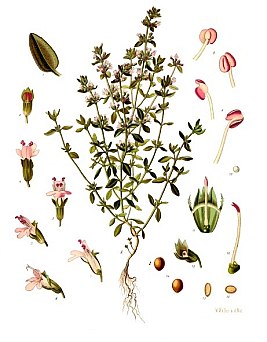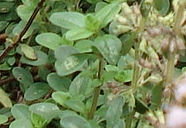Thyme Characteristics
(Thymus vulgaris)
 Name Origin: From the Greek word thyro, to sacrifice, due to its use as incense to perfume the temples. Read more on the History of Thyme.
Name Origin: From the Greek word thyro, to sacrifice, due to its use as incense to perfume the temples. Read more on the History of Thyme.
Natural Order: Labiatæ
Growing Cycle: Short, Shrubby Perennial
Origins: Native to dry, stony places on the Mediterranean coasts.
Height: Usually under 12 inches.
Characteristics: Branched, slender, and woody stems that bear oblong, triangular, tapering leaves that are usually 1/4 to 1/2 inch long. The leaves are green on top and gray underneath.
Thyme Flowers: Little pink or lilac which form whorls and loose, leafy spikes.
Fun Fact: Thyme, particularly the low-growing species, are quite popular with gardeners making miniature and Fairy Gardens. There are many varieties to choose from and we’ve discussed them separately on our creeping thyme and Silver-Edged Lemon Thyme article.
How to Grow Thyme

(thyme seeds, sowing, cultivation, propagation, harvesting thyme leaves, harvesting thyme seed and wintering.)
Thyme Seeds
There are approximately 170,000 thyme seeds per ounce and 24 ounces will fill a quart container. Thyme seeds retain their germinating power for three years. Cuttings, layers and divisions all work well but the easiest way to grow thyme is from seed.
Growing Thyme From Seed
Because the seeds are so tiny, thyme seeds should be sown very shallowly or pressed into the soil with a fine layer sprinkled on top. Better to plant seed in a nursery bed where more attention can be paid to the tiny plants. This will also enable the more valuable garden space to be used for an earlier-maturing crop.
In the seedbed, plant thyme seeds in early spring with the drills 4 to 6 inches apart with 5 or 6 seeds per inch. If planting in volume, mix sand with the seed to prevent over-planting. Some farmers use as much as 4 parts sand to one part seed.
If you are considering growing thyme and adding it to your garden plan, you might want to check out our Thyme Companion Planting to ensure the best possible yields from all of your herbs, flowers and vegetables.
Thyme Cultivation
Thyme plants should be planted no closer than 8 inches apart. Ten inches is preferred but one plant per square foot is optimal.
Young, growing thyme plants should be set out in the garden or field in June or July, preferably in damp ground or just prior to a rain shower.
Thyme Propagation
Thyme can be propagated by dividing the roots (should be done in April) and from seed. The finest plants are produced when grown from seed. However, Lemon Thyme smells sweeter when grown from cuttings or root divisions.
Harvesting Thyme
Harvest alternating plants in late August or early September. Harvest plants from alternating rows around three weeks later and the final crop of thyme should be harvested in October. If harvesting for drying, it’s best to harvest thyme just as they come into flower.
Harvesting Thyme Seeds.
Thyme matures unevenly from plant to plant.
While cutting the ripening tops is one way to obtain seeds, use of cloths, sheets, or paper bags may prove more productive. Around noon and again in late afternoon, gently shake the plants to encourage the ripe seeds to fall onto the sheets or into the bags. Collect the seeds and spread them in a warm, airy room to finish drying. Do keep in mind if the plants are wet or damp the tiny seeds may stick to the leaves and flower heads.
Wintering Thyme
In colder climates, mulch your thyme plants with leaves or other garden litter to prevent undue thawing and freezing. In the spring, for best results; dig the plants, divide and plant in a new location.
Thyme Uses
(leaves and thyme oil)
Thyme Leaves
 Either fresh or dried, thyme leaves are used for flavoring soups, gravies, stews, sauces, sausages, dressings and many other dishes.
Either fresh or dried, thyme leaves are used for flavoring soups, gravies, stews, sauces, sausages, dressings and many other dishes.
Thyme Oil
All parts of the thyme plant are fragrant because of the fairly high concentration of volatile oil. Like olive oil, there are grades of thyme oil with the first distillation being the most aromatic and desired. Both grades are used in perfumery and soap making. Some use the crystals that can form in thyme oil as a disinfectant.